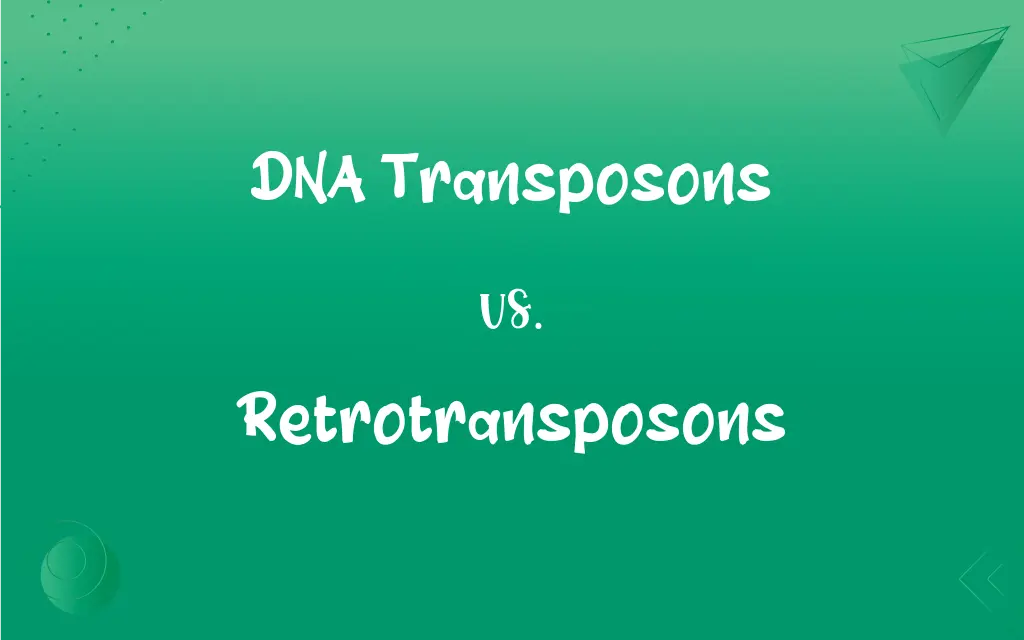DNA Transposons vs. Retrotransposons: What's the Difference?
Edited by Aimie Carlson || By Janet White || Published on February 27, 2024
DNA transposons move directly within the genome, while retrotransposons use an RNA intermediate for movement.

Key Differences
DNA transposons, also known as "jumping genes", move within the genome without making an RNA intermediate. Retrotransposons, in contrast, replicate through an RNA intermediate, which is then reverse-transcribed into DNA.
DNA transposons use a "cut and paste" mechanism, excising themselves from one location and integrating into another. Retrotransposons typically use a "copy and paste" mechanism, leaving the original copy in place and inserting a new one elsewhere.
The activity of DNA transposons is typically lower in eukaryotic organisms compared to retrotransposons, which are more abundant and active, especially in mammalian genomes.
DNA transposons are less likely to cause mutations because they often insert into non-coding regions. Retrotransposons, due to their abundance and random insertion, have a higher potential to cause genetic mutations.
DNA transposons are structurally simpler, containing only a few genes. Retrotransposons are more complex, often containing additional sequences like long terminal repeats (LTRs).
ADVERTISEMENT
Comparison Chart
Mechanism
Move directly within the genome
Use an RNA intermediate
Replication Process
"Cut and paste" method
"Copy and paste" method
Abundance in Eukaryotes
Typically lower
Higher, especially in mammals
Mutation Potential
Lower, often inserts into non-coding regions
Higher due to random insertion
Structure
Simpler, with few genes
Complex, often with long terminal repeats
ADVERTISEMENT
DNA Transposons and Retrotransposons Definitions
DNA Transposons
Genetic elements that move directly within the genome.
Scientists discovered a new DNA transposon in the fish genome.
Retrotransposons
More abundant and active in mammalian genomes.
Retrotransposons are a major component of the human genome.
DNA Transposons
Elements that use a cut-and-paste mechanism for movement.
DNA transposons can excise themselves from one part of the genome and integrate elsewhere.
Retrotransposons
Genetic elements that replicate through an RNA intermediate.
Retrotransposons contribute significantly to genome evolution.
DNA Transposons
Less likely to cause mutations due to targeted insertion.
The insertions by DNA transposons are usually in non-coding regions, minimizing mutations.
Retrotransposons
Utilize a copy-and-paste mechanism.
Retrotransposons can increase their numbers within the genome.
DNA Transposons
Typically less active in eukaryotic genomes.
DNA transposons are not as common in human DNA as retrotransposons.
Retrotransposons
Often contain long terminal repeats.
LTR retrotransposons are a common type in many species.
DNA Transposons
Structurally simple genetic elements.
The DNA transposon identified was notable for its simple structure.
Retrotransposons
Higher potential for causing mutations.
The random insertions by retrotransposons can disrupt gene function.
Retrotransposons
A transposon copied from RNA with the use of reverse transcriptase.
Retrotransposons
Plural of retrotransposon
FAQs
What defines retrotransposons?
Retrotransposons are genetic elements that replicate through an RNA intermediate.
How do DNA transposons move?
They use a "cut and paste" mechanism, excising and reinserting themselves.
What are DNA transposons?
DNA transposons are genetic elements that can move within the genome.
Are DNA transposons common in human DNA?
They are present but less active compared to retrotransposons.
How are DNA transposons identified?
Through genetic sequencing and bioinformatics analysis.
Are retrotransposons a mutation risk?
Yes, due to their random insertion patterns.
Do retrotransposons have a complex structure?
Yes, they often include additional sequences like LTRs.
What role do retrotransposons play in evolution?
They significantly contribute to genetic variation and evolution.
Do DNA transposons often cause mutations?
Less frequently, as they tend to insert into non-coding regions.
What is the replication mechanism of retrotransposons?
They replicate via a "copy and paste" method, creating new copies.
What is the structure of DNA transposons?
They have a simpler structure with fewer genes.
Are DNA transposons still active?
Some are, but many are now inactive in the human genome.
Do retrotransposons influence gene regulation?
They can, by inserting into or near regulatory regions.
How do DNA transposons contribute to genetic disorders?
Rarely, they can disrupt genes or regulatory regions.
How prevalent are retrotransposons in mammalian genomes?
Very prevalent, making up a significant portion of the genome.
Can DNA transposons affect gene expression?
Yes, if they insert near or within a gene.
Are retrotransposons linked to diseases?
Yes, their insertion can sometimes lead to genetic diseases.
Can retrotransposons be beneficial?
Yes, they can contribute to genetic diversity.
What is the impact of retrotransposons on genome size?
They can significantly increase genome size.
Can DNA transposons be used in genetic research?
Yes, they are used as tools in genetic engineering and research.
About Author
Written by
Janet WhiteJanet White has been an esteemed writer and blogger for Difference Wiki. Holding a Master's degree in Science and Medical Journalism from the prestigious Boston University, she has consistently demonstrated her expertise and passion for her field. When she's not immersed in her work, Janet relishes her time exercising, delving into a good book, and cherishing moments with friends and family.
Edited by
Aimie CarlsonAimie Carlson, holding a master's degree in English literature, is a fervent English language enthusiast. She lends her writing talents to Difference Wiki, a prominent website that specializes in comparisons, offering readers insightful analyses that both captivate and inform.
































































